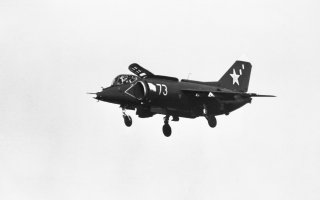Russia's Yak-38 Forger Was a Revolutionary Fighter Jet (for All the Wrong Reasons)
The jet succeeded only in exposing the crippling limitations of early VTOL aircraft technology.
Here's What You Need to Know: The Yak-38 was a poisoned chalice--a remarkable technological achievement with little practical value.
One of the most innovative fighters of its time, the Yak-38 (NATO reporting name “Forger”) was meant to mark a new chapter in Soviet naval doctrine. Instead, it succeeded only in exposing the crippling limitations of early VTOL aircraft technology.
In the decades following the Second World War, Soviet naval strategists took an increasing interest in aircraft carriers as a tool of maritime power projection and forward deployment. But the Soviet Union, much unlike its U.S. counterpart, was a land power; as such, the Soviet Navy was unwilling to commit to a heavy-class aircraft carrier with a properly elongated flight deck. The Soviets were less interested in single-purpose aircraft carriers than they were in a kind of hybrid cross between a carrier and battleship: in Soviet terminology, a “heavy aviation cruiser” that boasts formidable firepower while doubling a limited launch deck for certain fighter models.
Soviet strategists watched with keen interest as the British debuted the Hawker Siddeley P.1127, the first jet fighter capable of landing and taking off vertically, in 1960. The Soviet Navy promptly concluded that vertical take-off and landing (VTOL) technology was the ideal complement to their vision of a heavy cruiser, and so the Soviet aviation industry got to work on a VTOL fighter. Their first attempt spawned the Yak-36 experimental fighter, powered by two R-27 turbojets and equipped with vector-thrust rear nozzles. It took five years, and four prototypes, to incorporate a functional thrust vectoring system that supported reliable take-off action. The research and development experience of the Yak-36 finally led to the 1976 introduction of the Yak-38, a serially-produced VTOL strike fighter designed for full compatibility with the new Soviet Kiev aviation cruiser.
A remarkable showcase of ambitious aircraft engineering, the Yak-38’s VTOL capabilities stems from one Soyuz R-28 engine and two Rybinsk RD-36 lift turbofans. Though the VTOL system generally worked, the jump jet integration made the Yak-38 notoriously difficult to operate and virtually impossible to master even by veteran pilots. Outside of a higher chance of operator error, a mechanical failure in either of the two jets would cause the fighter spin out of control. Testing runs during the Soviet occupation of Afghanistan discovered that the fighter produced a massive cloud of dirt, dust, and debris when taking off on certain surfaces, not only threatening to clog up the engine but posing a potential hazard to personnel in its vicinity. It didn’t help that the Yak-38’s “smart” ejection mechanism, meant to protect the pilot by automatically ejecting their seat if the aircraft rolls past 60 degrees, was prone to accidental triggers.
Even setting aside these reliability problems, the Yak-38’s performance as a fighter was underwhelming. The first Yak-38 variant had an ideal range of no more than 320 km, severely constraining its viability as a tool of Soviet naval power projection. Its lack of a radar and anemic weapons loadout of just four hardpoints, typically filled by Kh-23 air-to-surface and R-60 air-to-air missiles, casts its usefulness as an attack aircraft into doubt. Unlike the prolific British Sea Harrier, which entered service in 1968, the Yak-38 lacked the payload and armament potential to play a meaningful battlefield role in most scenarios.
After attempting to salvage the fatally flawed Yak-38 with a slew of unimpressive variants over the next several decades, the Soviets finally gave up on VTOL fighters shortly prior to the 1991 collapse.
The Yak-38 was a poisoned chalice--a remarkable technological achievement with little practical value. The Soviet navy got a barely functional VTOL aircraft, but the Yak-38’s massive performance tradeoffs and reliability issues over conventional fighters were simply not worth it.
Mark Episkopos is the new national security reporter for the National Interest.
This article first appeared earlier this year.
Image: Wikimedia Commons

